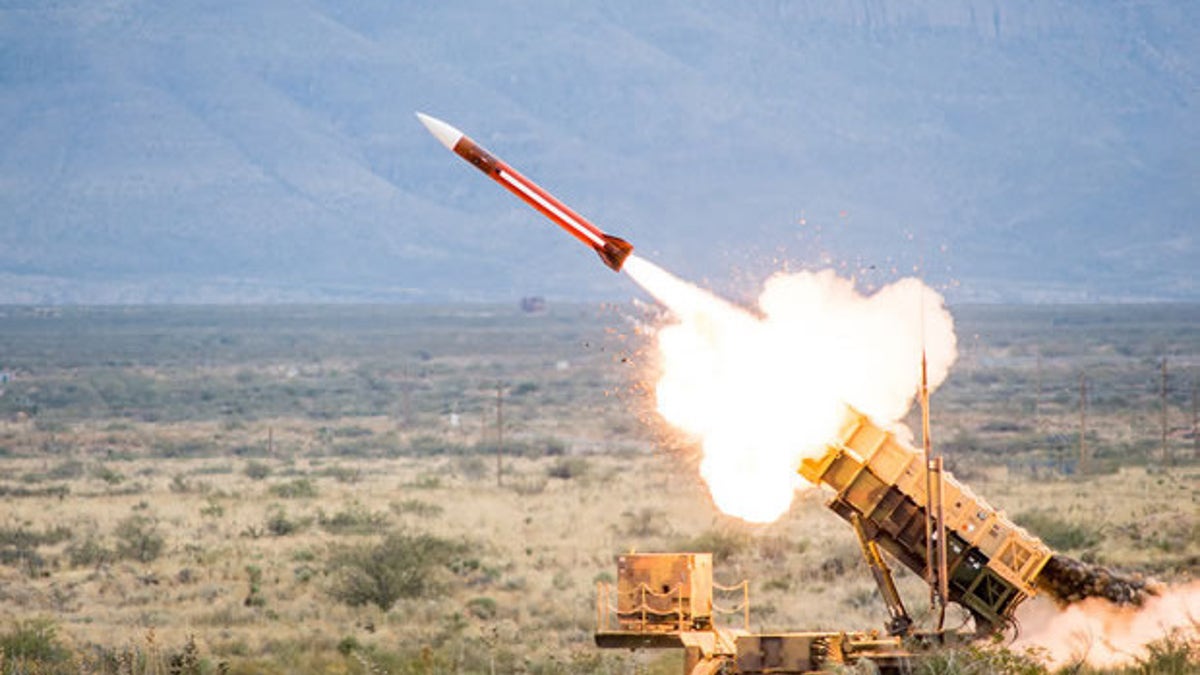
Patriot missile file photo. (Raytheon Company)
They exploded Saddam’s Scud missiles right out of the sky, intercepting what would have been destructive explosions on U.S. forces. They surprised global observers and saved American lives during the Gulf War in the early '90s -- Patriot Missiles. The Patriot, seen as an emerging and highly impactful war technology at the time, was first fired in war about 30 years ago
Now, the Patriot lives to fight another day and is expected to function for years to come. The weapon could serve for as long as four decades or beyond.
How? The Patriot has been brought into the modern area through a series of extensive upgrades. The kinetic-energy hit-to-kill Patriot Advanced Capability weapon, in particular, has received new software, modern sensors and a special upgrade called Missile Segment Enhancement.
Raytheon weapons developers also explain that the Patriot will be fielding a new, gamer-style interface that makes the system easier to operate. And the current radar has been modernized, as well, better enabling it to detect incoming threats, and discriminate and defend against them, an expert Raytheon developer explained.
Nevertheless, while the Patriot continues to remain operational and effective in many respects, the system will start facing challenges when it comes to confronting increasingly advanced attacks, Raytheon and Army developers said.
PENTAGON DEPLOYS NEW SUB-LAUNCHED, LOW-YIELD NUCLEAR MISSILE
Alongside continued use of the Patriot, the Army is also now engineering a new, more efficient and more sensitive new ground radar called Lower Tier Air and Missile Defense Sensor (LTAMDS).
The significance of LTAMDS, as a complement to the Patriot, is outlined in the Army Air & Missile Defense 2028 Vision document. The essay specifies some of the more challenging specifics associated with newly emerging drone, helicopter, aircraft and ballistic missile threats. For instance, regarding ballistic missile threats, the Army Vision essay explains that advanced weapons are now engineered with “countermeasures, maneuverable re-entry vehicles, multiple independent reentry vehicles, hypersonic/supersonic glide vehicles and electronic attack.”
“The LTAMDS can go off road, through tunnels and bridges,” Bob Kelley, Raytheon's director of IAMD (Integrated Air and Missile Defense] Domestic Programs for Business Development and Strategy, told Warrior in an interview.
The new LTAMDS achieves its margin of difference by, among other things, optimizing power, performance and RF efficiency through the use of a highly-capable semiconducting material known as Gallium Nitride (GaN).
SOLDIERS USE AI TO FIRE PRECISION GRENADES, GUIDE DRONE ATTACKS
“GaN is a more efficient and more powerful RF transmitter. We are producing military grade ultra-high efficiency GaN. It’s a highly efficient material which does not require as much cooling as a Patriot transmitter does today, because it conducts heat efficiently,” Kelley said. “The array converts material into RF energy to ‘go out and search and detect.’”
Interestingly, despite the need for an emerging system such as LTAMDS, the Army plans to sustain and deploy the Patriot for many years to come and help “take full advantage of the Patriot Missile Segment Enhancement (Patriot upgrade) capability,” Natalia Thaniel, director of communications, Army Futures Command, Air and Missile Defense Cross Functional Team, told Warrior in a statement.
The Army’s Air & Missile Defense Vision 2028 appears to mirror Thaniel’s comment by stating that “The LTAMDS maximizes the full kinematics of the Patriot missile set.”
The LTAMDS principal advantage, apart from being longer range and more sensitive, is its ability to sustain a track on a fast-maneuvering threat such as a cruise missile.
HOW AI CHANGES ATTACK MISSIONS FOR US FIGHTER JETS AND BOMBERS
“The challenge with maneuvering cruise missiles is that maintaining a track on them depends upon how a radar updates. There is no time for a blind spot. LTAMDS uses three fixed 120-degree arrays. The longer I am looking at a track, the more information I am building up about it. We have no blind spot as there is an overlap between the fixed arrays,” Kelley said.
Stealthy 5th-gen aircraft, which both Russia and China are known to possess, can increasingly operate at lower altitudes with precise air-to-ground weapons. Given their speeds, establishing a consistent radar “track” can seem nearly impossible. Alongside these threats, the Army Vision document also specifies major power cruise and ballistic missile threats.
“Numerous countries are developing ground-, sea-, and air-launched land-attack CMs [cruise missiles] using an assortment of unconventional and inexpensive launch platforms. In addition, long-range, low-observable, advanced CMs enable our adversaries to present a complex air and missile defense problem with high-volume, high-precision missiles capable of 360-degree avenues of approach,” the Army Vision document states.
The LTAMDS is, to a large extent, engineered to optimize the use of radar signals that can detect and track small objects or air-vehicle segments with great fidelity at long distances. The faster a ground commander can learn of an approaching threat, the greater the sphere of response options available. Using advanced fire control systems, an LTAMDS can receive and organize incoming electromagnetic “pings” and produce a “rendering” of a threat object. Precision ground-defense radar such as LTAMDS can generate the shape, size, distance and speed of an approaching threat. Since radio frequency travels at the speed of light, a known entity, and the time of travel can be determined … a computer algorithm can then determine the exact distance of a threat object.
CLICK HERE TO GET THE FOX NEWS APP
“There is no time for a blind spot now,” Kelley said.
